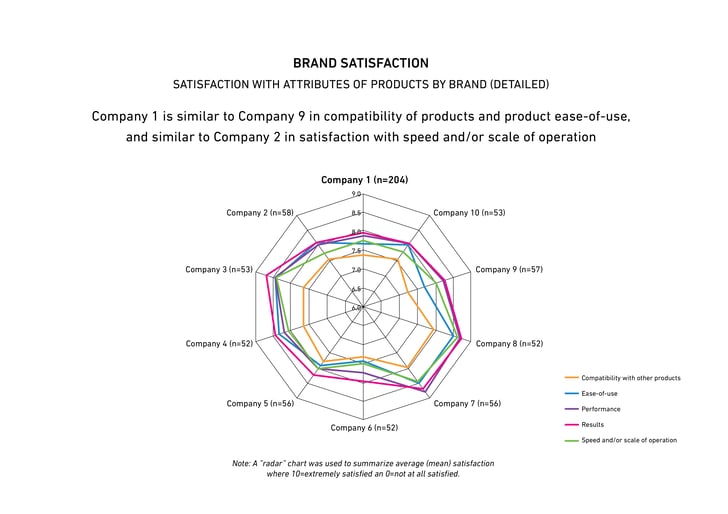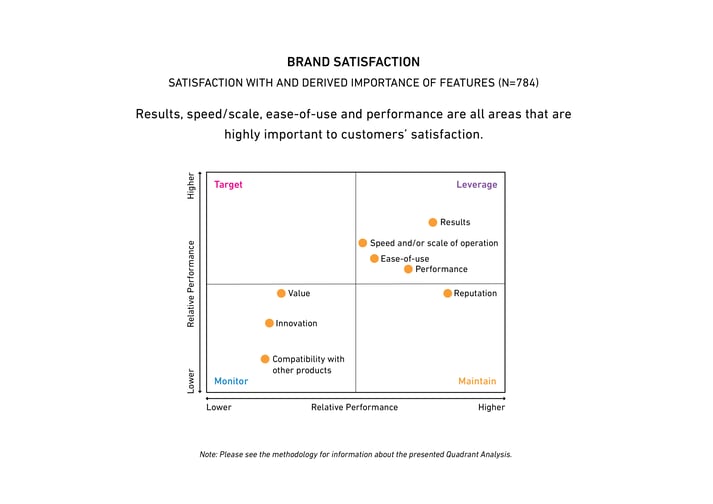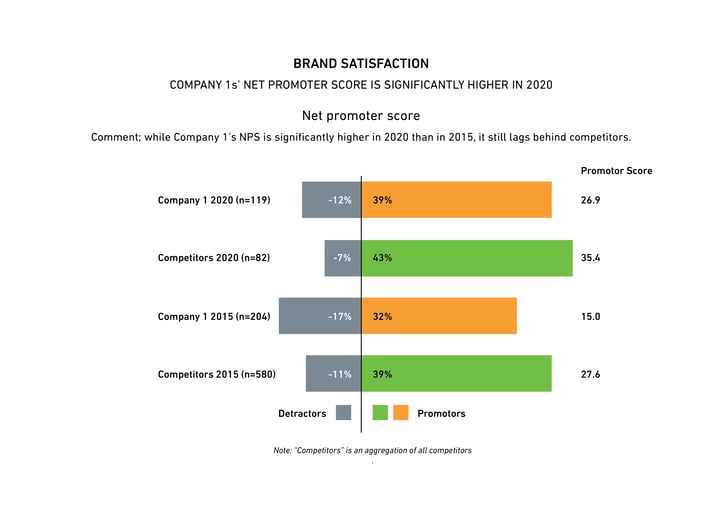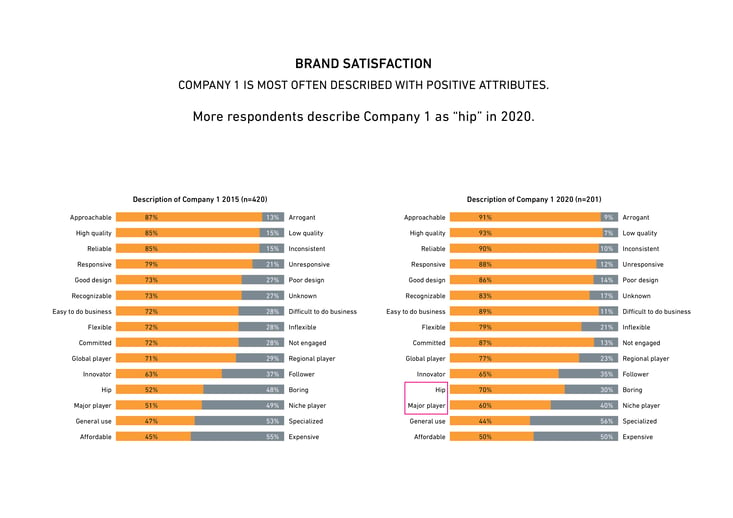We know when brands are healthy. Household names that we associate with solving acute problems and exhibiting values that resonate strongly with our own. Conversely, it’s also easy to see a brand deteriorating as they stumble through PR disasters and make decisions that alienate their once loyal customers. While both of these are easy to see, they are extremes, and most brands will fall somewhere on a spectrum in between.
How do brands ensure their own health? The good ones, no doubt, start by taking a close look at their brand personality and how their customers view it.
Where a brand falls on this health spectrum is extremely valuable information for a company wanting to make improvements. However, as you start trying to assign numbers and values, the ethereal nature of a brand becomes painfully clear. It may seem to be something that cannot be quantified.
At least, not on the surface.
The first challenge, then, is how can we take the concept of a brand and make it more concrete and easier to describe without losing any of the complexity? Humans are very good at observing and describing other humans and not as good at describing abstract concepts like brand perception. So, the question arises, what if we personify the brand?
Personifying a brand
What if, instead of describing the brand, we describe a person that perfectly captures the essence of the brand? When you think about it, many brands do reflect the personalities of their charismatic CEOs. Look at how the Apple brand reflects Steve Jobs and how Microsoft embodies many of the characteristics of Bill Gates. This resemblance did not go unnoticed and was the focus of an ad campaign by Apple to highlight their fun and youthful brand compared to Microsoft, who was portrayed as stuffy and boring.
By personifying a brand, you have a whole new vocabulary to describe precisely how your brand is perceived. Is your brand approachable or arrogant? Shy or outgoing? These words give you a vivid picture of your brand and bring it to life. It also turns out that people are really good at turning brands into people. We can effortlessly think of brands as having personalities that we can either accept and embrace or reject and dislike.
An important breakthrough, but not enough
Generating a new toolbox for personifying and describing brands is unfortunately not enough. To really quantify a brand, we need data, and lots of it. Data means asking lots of relevant people to personify a brand so that we can analyse a statistically relevant dataset that will generate enough information to assign real values to a brand.
The problem, however, is finding enough people who could help generate meaningful data. Until recently, the only way to do this was to hire companies that offer panels of people who could answer survey questions on your behalf. This approach is unfortunately extremely limited when you consider how small the panels are, how little experience of a brand the members often have and how frequently they are reused. But what if we tried another way?
“Getting to the root of your brand personality requires you to perform market research, by talking to the people who have real-world experience of your brand.” - Elizabeth Nelson, Head of UP Lab.
Using the cloud to gather research
Today there are cloud-based solutions that let you quickly reach people in every corner of the globe. The technology means that you can dream up the perfect set of people to assess your brand and you’ll be able to find them.
Need a panel who are keen mountain bikers? You’ve got it!
Need a panel of scientists working on genome editing? You’ve got it!
Need woodworkers who use a specific kind of adhesive? You’ve got it!
Not only will you be able to find them, but you’ll be able to find them in large enough numbers to collect a meaningful dataset for your brand survey.
When we put this together at UP to form UP Lab, we knew that we had something special. The detail and accuracy that could be provided by personifying brands was the first part. Providing large, specific panels of people to assess the brand was the second. Let’s take a look at an example of how it works.
Testing the cloud-based panel with real people
We conducted a far-reaching brand survey for one of our clients using the power of the cloud, and the responses were exceptionally revealing. We noticed that everyone, including employees of the company as well as customers, were incredibly honest about how they perceived the brand— to the point of being blunt. Personifying the brand gave them the tools and vocabulary to do this but creating a persona also helped to distance people from the brand just enough to allow them to give more honest opinions.
These results in themselves were of immense value. There was no need to diagnose any problems with the brand. There was no need to formulate a diplomatic way to say, “sorry but your brand sucks at the moment”. The answers and some harsh truths were all there in black and white.
“Whatever people think about your brand is what it is to them.” - Robert England, Head of UP FOR LIFE.
When we then crunched the numbers and analysed the survey responses, we found that we could also very accurately quantify how people saw the brand.



Making the results useable
When we presented the findings at our client’s annual meeting, we wanted to find a way to truly exemplify the brand. We hired actors to personify the brand and attend the meeting in person. They were invited up on stage to really solidify the results in people’s minds. This memorable stunt was a crowd pleaser but served a deeper purpose. By etching the brand persona into people’s minds, it became easier afterwards to make everyday decisions to improve the brand.
During every customer interaction, employees at the company could decide how they were going to embody a new brand persona by adopting facets of the personality. By personifying the brand, you make it easier to infuse values into every member of a company making positive change inevitable.
“Everything you say and do, affects your brand.” - Julian Stubbs, Founder and CEO of UP THERE, EVERYWHERE.
The client’s first brand assessment five years ago became a baseline from which to move forward. After five years, our client reached out to us to do a follow up survey to see if their brand health had improved. We were excited to see measurable improvements in several key brand metrics, including how likely someone was to promote the brand to someone they knew.

We also saw a measurable change in the characteristics and the “personality” of the brand as it shifted closer to where the company hoped it would be. This taught us two important things about the work that we did:
1 – Set a baseline as soon as possible
Our client did a survey five years ago which meant they were able to measure changes today. Without setting a baseline it will be impossible to accurately navigate through the murky waters of improving brand perception. Set a baseline, understand where your brand is and work on improving it.
2 – Brands don’t jump, they slide
Seismic shifts in brands don’t happen from one day to the next. However, gradual changes along a continuum do happen. We were able to see this by collecting large amounts of accurate data over two different time points. Having data on your brand health can help you decide where to focus resources and which aspect of the brand can start to be improved.
All in all, this is some of the most meaningful and powerful research work that we have done at UP. We are able to accurately quantify the health of a brand and communicate in such a way that members of the company can adopt new desirable traits to improve the brand one interaction at a time.
Find out everything about your brand
If you are responsible for a brand, UP can give you a full measure of it, straight from the mouths of those who know it best – your people and your customers. We can also nurture your brand to new heights, building upon its authentic values. Talk to us today.
